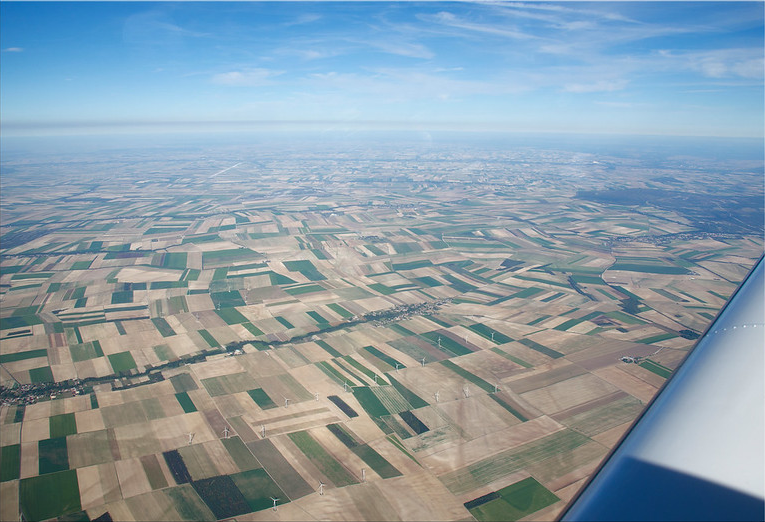July 24, 2020
The Netherlands is among the smallest and most densely populated countries in the world [12]. Yet, for the last couple of years it has been the second biggest exporter of agricultural products worldwide [2]. One could argue that the Dutch exporting position is simply due to re-export. However, more than 72 percent of the products were of Dutch origin. This means that after Brazil, the Netherlands has the second highest agricultural trade surplus of the world [2].
When you are about to land at Schiphol – the international hub airport of the Netherlands – you can see it: the endless, geometrical agricultural fields. For thousands of years the Dutch have been adapting the landscape according to their own needs and desires. As a result, there is a policy plan for every tiny piece of land.

Fig.1: Large rectangular farmland parcels seen from the sky [10]. Photo: Sally Jane Photographic Art, 1 October 2012
In order to make its agriculture more efficient, cost-effective, and simpler, the Dutch government forced farmers to join the Land Consolidation Act, thus leading to a tremendous landscape homogenization. As a matter of fact, all small land parcels were grouped and converted into larger and rectangular ones in the last century [6].
These developments have immensely decreased the number of farmers and expanded the size of the remaining farms [1]. Besides scaling up, many farms switched from mixed and extensive to monoculture farming for economic purposes. Unfortunately, this was not without consequences, as the vitality of the soil was put under great pressure [8].
The soil is home to countless worms, fungi, bacteria, and other microorganism that help both soil retaining water and plant roots absorbing nutrients. These are essential ecosystem services: by promoting plant growth and purifying water they sustain human life [5].
Monoculture farming means growing one plant species on the same piece of land. When the number of same plants on one square meter of land is too high, the amount of nutrients in the soil decreases. This, together with the use of synthetic fertilizers and heavy agricultural machinery, causes soil microorganisms and bacteria to die or migrate. Reduced soil life weakens the natural defences of crops and increases their vulnerability against pests [11].
Monoculture farming also means that soil is less and less able to retain moisture, causing the soil to slowly sink. As less moisture is retained, farmers must water their land more, which leads to enormous drops in groundwater levels. For a country that is below sea level for almost a third, these are serious issues [6]. Furthermore, in 84 percent of the cases, synthetic fertilizers and water absorption are responsible for the unhealthy state of conservation of protected ecosystems in the Netherlands [7].
On a global scale the consequences of modern farming are also colossal. The sector is one of the biggest contributors of global warming, responsible for 19 to 29 percent of all greenhouse gas emissions worldwide. The main reasons are cattle methane production, the deforestation of forest patches close to agricultural fields and the massive use of fossil fuels for production and transportation operations [13].
Moreover, heavy agricultural machinery and synthetic fertilizers cause soil depletion. In the short term, farmers can counteract by using even more synthetic fertilizers, but in the long term this is catastrophic. Our food production system is inextricably linked to the climate crisis. And it is being hit in the midst of it [5].
Perhaps agroforestry systems could be a solution to hinder soil depletion in Dutch farm fields. Indeed, agroforestry systems could be a way to restore land productivity of nutrient poor areas depleted by unsustainable agricultural practices [4].
To maintain quality production high and achieve the Paris Agreement targets, the Dutch government has set new policies to convert all Dutch farms into sustainable farms by 2030 [9]. A sustainable farm refers to an economic enterprise dedicated to food production and/or processing that balances environmental, social, and economic interests, i.e. that follows the triple bottom line.
On a smaller scale, Dutch citizens have come up with creative solutions aimed at changing the food production system. An example is the cooperative “Land van Ons” (Our Land), which was founded in September 2019. The fast-growing cooperative supports Dutch citizens to jointly purchase farms and manage them in a way that increases biodiversity. Its mission is to stop soil depletion and the loss of plant and animal species from the Dutch farmland [3].
Bibliography:
[1] CBS (2020). Landbouw. Retrieved on 14 July 2020, from https://www.cbs.nl/nl-nl/economie/landbouw/cijfers
[2] Jukema, G., Ramaekers, P., & Berkhout, P. (Ed.) (2020). De Nederlandse agrarische sector in internationaal verband. (Wageningen Economic Research report; No. 2020-001). The Hague: Wageningen Economic Research & Statistics Netherlands. Retrieved on 13 July 2020, from https://doi.org/10.18174/511255
[3] Land van Ons (2020, January). Oprichtingsakte en statuten Land van Ons. Retrieved on 15 July 2020, from https://landvanons.nl/wp-content/uploads/2020/01/Oprichtingsakte-en-statuten-Land-van-Ons-co%C3%B6peratie-geblokt.pdf
[4] Miller, M.L. (2019, 28 June). Agroforestry In Peru And Its Potential For Ecosystem Restoration. Retrieved on 23 June 2020, from https://greenmarked.it/blog/agroforestry-in-peru-and-its-potential-for-ecosystem-restoration/
[5] Mommers, J. (2019). Hoe gaan we dit uitleggen. Amsterdam: De Correspondent
[6] Van Poppel, J. (2020, 5 March). Hoe Nederland het schaakbord werd dat je van boven ziet. Retrieved on 13 July 2020, from https://decorrespondent.nl/10993/hoe-nederland-het-schaakbord-werd-dat-je-van-boven-ziet/1384268823729-835e4aff
[7] Pouwel, R. & Henkens, R. (2020, February). Naar een hoger doelbereik van de Vogel- en Habitatrichtlijn in Nederland. Retrieved on 14 July 2020, from https://zoek.officielebekendmakingen.nl/blg-931627.pdf
[8] Raad voor de leefomgeving en infrastructuur (2020, June). De bodem bereikt?! Retrieved on 13 July 2020, from https://www.rli.nl/sites/default/files/advies_de_bodem_bereikt_-_def.pdf
[9] Rijkswaterstaat (2018, 28 May). Doel 2030: alle Nederlandse landbouwgronden duurzaam bewerkt. Retrieved on 15 July 2020, from https://www.bodemplus.nl/actueel/nieuwsberichten/2018/doel-2030-alle/
[10] Sally Jane Photographic Art (2012, 1 October). Monoculture. Retrieved on 15 July 2020, from https://www.flickr.com/photos/sally-jane/8205601035/
[11] Tsiafouli, M.A., Thébault, E. […] Wolters, V., Hedlund, K. (2014). Intensive agriculture reduces soil biodiversity across Europe. Retrieved on 15 July 2020, from https://doi.org/10.1111/gcb.12752
[12] United Nations, Department of Economic and Social Affairs, Population Division (2019). World Population Prospects 2019. Retrieved on 13 July 2020, from https://population.un.org/wpp/DataQuery/
[13] Vermeulen, S.J., Campbell, B.M. & Ingram, J.S.I. (2012, November). Climate Change and Food Systems: Annual Review of Environment and Resources. Retrieved on 15 July 2020, from https://www.annualreviews.org/doi/pdf/10.1146/annurev-environ-020411-130608




